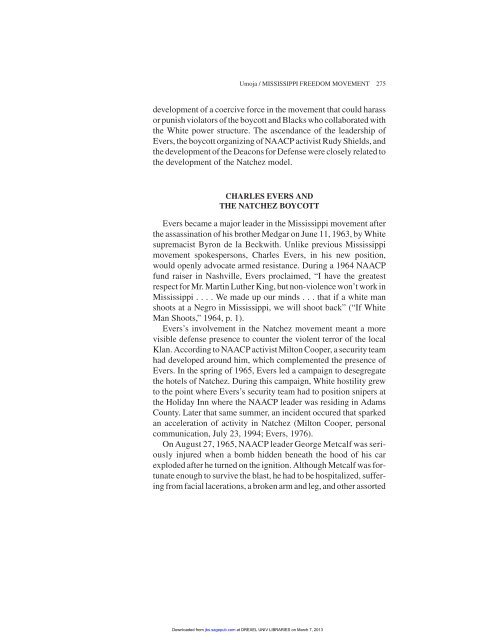MXGM Self-Defence Manual
MXGM Self-Defence Manual
MXGM Self-Defence Manual
Create successful ePaper yourself
Turn your PDF publications into a flip-book with our unique Google optimized e-Paper software.
Umoja / MISSISSIPPI FREEDOM MOVEMENT 275<br />
development of a coercive force in the movement that could harass<br />
or punish violators of the boycott and Blacks who collaborated with<br />
the White power structure. The ascendance of the leadership of<br />
Evers, the boycott organizing of NAACP activist Rudy Shields, and<br />
the development of the Deacons for Defense were closely related to<br />
the development of the Natchez model.<br />
CHARLES EVERS AND<br />
THE NATCHEZ BOYCOTT<br />
Evers became a major leader in the Mississippi movement after<br />
the assassination of his brother Medgar on June 11, 1963, by White<br />
supremacist Byron de la Beckwith. Unlike previous Mississippi<br />
movement spokespersons, Charles Evers, in his new position,<br />
would openly advocate armed resistance. During a 1964 NAACP<br />
fund raiser in Nashville, Evers proclaimed, “I have the greatest<br />
respect for Mr. Martin Luther King, but non-violence won’t work in<br />
Mississippi ....Wemadeupourminds...that if a white man<br />
shoots at a Negro in Mississippi, we will shoot back” (“If White<br />
Man Shoots,” 1964, p. 1).<br />
Evers’s involvement in the Natchez movement meant a more<br />
visible defense presence to counter the violent terror of the local<br />
Klan. According to NAACP activist Milton Cooper, a security team<br />
had developed around him, which complemented the presence of<br />
Evers. In the spring of 1965, Evers led a campaign to desegregate<br />
the hotels of Natchez. During this campaign, White hostility grew<br />
to the point where Evers’s security team had to position snipers at<br />
the Holiday Inn where the NAACP leader was residing in Adams<br />
County. Later that same summer, an incident occured that sparked<br />
an acceleration of activity in Natchez (Milton Cooper, personal<br />
communication, July 23, 1994; Evers, 1976).<br />
On August 27, 1965, NAACP leader George Metcalf was seriously<br />
injured when a bomb hidden beneath the hood of his car<br />
exploded after he turned on the ignition. Although Metcalf was fortunate<br />
enough to survive the blast, he had to be hospitalized, suffering<br />
from facial lacerations, a broken arm and leg, and other assorted<br />
Downloaded from jbs.sagepub.com at DREXEL UNIV LIBRARIES on March 7, 2013


